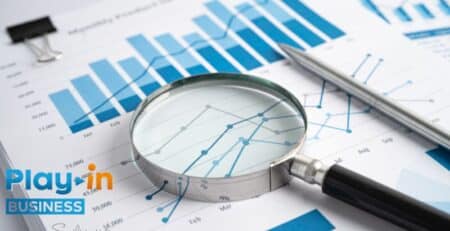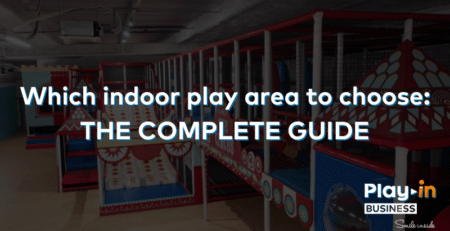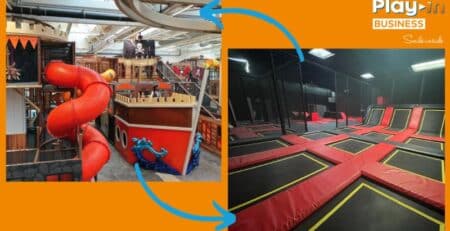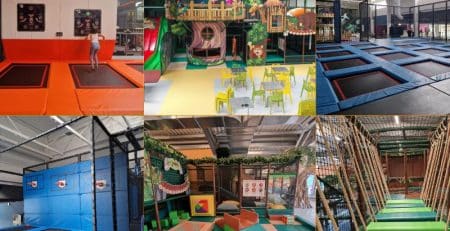How much does an indoor playground cost?
 Launching an indoor playground is like fulfilling a dream for many: creating a space of fun and safety where families and children can gather and enjoy themselves.
Launching an indoor playground is like fulfilling a dream for many: creating a space of fun and safety where families and children can gather and enjoy themselves.
However, behind the ambition lies a significant challenge: understanding and mastering the costs. The indoor leisure market, with a turnover of 7 billion euros in France, is booming. It is constantly reinventing itself, attracting customers eager for thrilling emotions and innovative experiences.
With nearly 5,000 companies, 30,000 employees, and 30 million customers in 2019, the sector is a true giant that continues to grow.
Embarking on this entrepreneurial venture, therefore, means seizing a golden opportunity, but it requires meticulous preparation and a sharp understanding of the necessary budgets. Let’s clarify the investment dossier to make your project a dazzling success.
Cost breakdown: investing to prosper
Strategic location choice: urbanity vs. periphery
 Choosing the right location is crucial in planning your indoor playground. Urban areas, with their population density, promise a large audience but also involve higher costs in terms of rent or purchase. Conversely, peri-urban areas often offer more attractive rates and more generous spaces, although the potential flow of visitors may be less significant.
Choosing the right location is crucial in planning your indoor playground. Urban areas, with their population density, promise a large audience but also involve higher costs in terms of rent or purchase. Conversely, peri-urban areas often offer more attractive rates and more generous spaces, although the potential flow of visitors may be less significant.
Analyze the local market to determine where your investment will bear fruit: a city center location, easily accessible, with high visibility, easy access, and plenty of parking, or on the outskirts. Parks like l’Île de Tortuga in Lille, Gulli Parc in Rouen, or Seven Squares, the first leisure complex in central Paris, demonstrate that a downtown location can be an expensive but wise choice.
Sizing the indoor playground: a key factor

The size of your indoor playground is not just a matter of space; it’s a strategic reflection on customer experience and operational capacity. The larger the space, the more customers you can accommodate and the greater the possibilities for varied activities, but this also means higher initial and operational costs. An optimized surface must balance the desired user experience and financial viability, ensuring that each square meter contributes to the site’s attractiveness while remaining economically justified.
Starting small can be a hindrance to development and lead to the failure of your park. In France, very few play areas operate with less than 600 square meters.
Equipment and layout: the heartbeat of the playground
Games and attractions: more than simple entertainment
 Game equipment is the very essence of your indoor playground. Ball pits, slides, trampolines, monkey bridges, tunnels, punching bags, interactive games, ninja kid courses, electric go-kart tracks—each installation is a call to adventure for children. Costs vary widely, from basic installations around €100,000 excluding VAT for a basic playground to more sophisticated attractions that can exceed €300,000 excluding VAT. Consider longevity and appeal: higher-quality equipment may represent a higher initial investment but ensures a longer lifespan for the games and requires fewer repairs in the medium and long terms.
Game equipment is the very essence of your indoor playground. Ball pits, slides, trampolines, monkey bridges, tunnels, punching bags, interactive games, ninja kid courses, electric go-kart tracks—each installation is a call to adventure for children. Costs vary widely, from basic installations around €100,000 excluding VAT for a basic playground to more sophisticated attractions that can exceed €300,000 excluding VAT. Consider longevity and appeal: higher-quality equipment may represent a higher initial investment but ensures a longer lifespan for the games and requires fewer repairs in the medium and long terms.
Decoration and theming: building a world of escape
The ambiance of your space plays a crucial role in attracting customers loyalty. A well-crafted theme, whether it evokes the world of space, the jungle, the city, or a pirate ship, can transform a simple visit into an unforgettable adventure for both children and parents. The budget for decoration can range from a few thousand euros to several tens of thousands of euros, depending on the complexity and quality of the fittings. Investing in a unique and captivating design is a powerful lever to stand out from the competition and create memories that encourage return visits.
Safety and compliance: non-negotiable priorities
Safety standards: a non-negotiable commitment

Safety has a cost. Buying equipment directly from abroad (from China, for example) may seem financially very attractive. However, although they claim compliance with safety standards (EN1176), very few manufacturers outside the European Union have actually passed the tests, and their certificates are fake. You then end up with games that can be dangerous, and your responsibility as an operator and importer will be fully engaged in the event of an accident. Bringing into compliance can lead to tens of thousands of euros in work and certification.
Purchasing a game from a European manufacturer – who must comply with the EN1176 standards and provide a proper certificate of compliance – ensures the safety of children and your peace of mind as an operator. It will also be easier to maintain and inspect your equipment.
Insurance: essential coverage for your operation
 Insurance is a central pillar of your risk management. It must cover classic risks (theft, vandalism, fire, water damage, operational loss) and also your civil liability.
Insurance is a central pillar of your risk management. It must cover classic risks (theft, vandalism, fire, water damage, operational loss) and also your civil liability.
However, your responsibility is limited to providing equipment that complies with safety standards and maintaining this equipment in perfect condition. The use of children’s games is the responsibility of the parents or adults accompanying the children. An operator’s liability in the event of an accident is often disengaged by noting that the origin of the problem comes from improper use (climbing up a slide the wrong way, multiple jumps on a trampoline) or a collision between children.
The annual insurance premium will only vary based on the amount of coverage requested. An average premium is around €5-6,000 for 1000 m².
It is, however, advisable to ensure that your equipment always remains clean, in perfect condition, and compliant with current regulations so that your insurer has no reason to refuse to cover you in the event of an accident.
Management it: optimizing for efficiency and customer experience
Management system: more than just transactions

The management of flows is the central nerve of your indoor playground. Your management system must allow you to quickly admit customers into your park, control their exits, manage sales at the bar, birthdays, and if possible, room reservations with ease and efficiency. Software exists that generally includes terminals, tablets, and of course one or more cash registers with a ticket printer. The cost of a complete system with software and complete point-of-sale computer hardware can vary from €5,000 to €15,000, depending on the options chosen (software rental or purchase, RFID management, online birthday reservations, etc.)
Tracking and management technology: at the heart of operational efficiency
Management software not only serves for cashing in but can also be real CRM tools allowing you to monitor critical aspects such as stock, attendance, and equipment maintenance. They can serve to enhance the customer experience by offering valuable insights into buying behavior and visitor preferences.
Investing in these technologies, generally costing €150 to €300 per month, helps you detect inefficiencies, reduce operational costs, and make decisions based on reliable data, ensuring that your business runs like a well-oiled machine.
Marketing and advertising: making your playground known
Launch strategies: highlighting your playground
 An effective launch strategy is key to generating buzz around your new indoor playground. It’s not enough to just open the doors; you need to attract attention. Investing in advertising campaigns, both online and offline, ensures maximum visibility. Costs can vary widely, from €1,000 to €20,000, depending on the scale and medium chosen. Online campaigns, via social media or search engine marketing, can be particularly targeted and cost-effective, while local displays or ads in traditional media can effectively increase local awareness.
An effective launch strategy is key to generating buzz around your new indoor playground. It’s not enough to just open the doors; you need to attract attention. Investing in advertising campaigns, both online and offline, ensures maximum visibility. Costs can vary widely, from €1,000 to €20,000, depending on the scale and medium chosen. Online campaigns, via social media or search engine marketing, can be particularly targeted and cost-effective, while local displays or ads in traditional media can effectively increase local awareness.
Branding: creating an identity that resonates
Branding goes beyond the logo; it’s the soul of your indoor playground. Developing a strong visual identity and an attractive website is fundamental to connecting with your audience. Costs for these essential branding elements include graphic design, web development, and the production of promotional material, often totaling between €5,000 and €15,000 or more. Successful branding tells the story of your indoor playground, evokes emotions, and creates a lasting connection with customers, helping to build a loyal and engaged community around your brand.
Staff costs: investing in talent
 The quality of your team can make or break the reputation of your indoor playground. If you need a director or a management team, you may need to go through a recruitment agency (costing between 15 and 20% of the annual gross salary). This cost should be considered in light of a “failed” recruitment, which would involve much higher expenses.
The quality of your team can make or break the reputation of your indoor playground. If you need a director or a management team, you may need to go through a recruitment agency (costing between 15 and 20% of the annual gross salary). This cost should be considered in light of a “failed” recruitment, which would involve much higher expenses.
Then, investing in training your team is essential to offer an exceptional customer experience. Most of the time, it is the management team that conducts the training. Plan for 7 to 15 days of training depending on the size and complexity of your park for each employee. These upfront investments ensure that your team has the skills and experience necessary to meet visitor needs and create the brand image you want to achieve.
Salaries: a continuous commitment to your team
Salaries constitute a significant part of operational expenses, but fairly compensating your employees is crucial for maintaining morale, motivation, and loyalty. Salary costs vary depending on the number of employees, specific roles, and geographic location, but count on an annual payroll that can represent 30% of operating expenses. Ensuring competitive and fair wages is an investment in the stability and productivity of your business, fostering a positive work environment and quality customer service.
Maintenance and repairs: ensuring the longevity of your playground
Regular maintenance: a duty towards quality
 Regular maintenance of equipment and facilities is crucial to ensure safety, comfort, and the continued enjoyment of visitors. Allocating a budget for regular maintenance helps prevent degradation and extend the lifespan of the facilities.
Regular maintenance of equipment and facilities is crucial to ensure safety, comfort, and the continued enjoyment of visitors. Allocating a budget for regular maintenance helps prevent degradation and extend the lifespan of the facilities.
While cleaning, visual inspections, and simple repairs can be performed by your teams, the intervention of a maintenance company is advised for annual checks and technical repairs. Count between €1,000 and €2,000 excluding VAT (depending on the importance of the games) from the 2nd year of operation for a basic contract, and €2 to 3,000 from the 3rd year for replacing worn parts.
Turning investment into success
Launching an indoor playground is a journey that mixes dreams and challenges. This significant investment, although substantial, opens a door to a world of opportunities. With rigorous planning and a well-thought-out strategy, your project will not only be profitable but will also bring you immense personal satisfaction. The key lies in meticulous cost management, a deep understanding of the market, and a commitment to operational excellence.
 If the idea of opening your own indoor playground motivates you, Play In Business is here to turn your vision into reality. Contact us for a thorough and personalized consultation. Together, we will develop a plan that not only meets your financial expectations but also enriches community life. Don’t let your questions hinder your ambitions. Take the first step towards the success of your fun and sustainable business with Play In Business.
If the idea of opening your own indoor playground motivates you, Play In Business is here to turn your vision into reality. Contact us for a thorough and personalized consultation. Together, we will develop a plan that not only meets your financial expectations but also enriches community life. Don’t let your questions hinder your ambitions. Take the first step towards the success of your fun and sustainable business with Play In Business.
For those interested in financial aspects, do not miss our detailed article “Indoor play area: how to finance it?“. A valuable resource to guide you through financing options and ensure the success of your investment project.







































